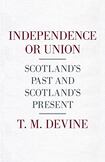
Tom Devine’s latest work is partially a summary of his previous research as seen through the prism of Scotland’s place and influence in the union. This descriptive, wide-ranging book covers not only 300-plus years of Scottish history, but the huge changes, the rise and fall of ideas and powerful forces, along with this nation’s place in a wider context, most critically its relationship with England, but also its European neighbours, and with empire and commonwealth.
Devine tells much of the story of Scotland pre- and post-union. There is a sense of balance and geopolitical awareness for the Scotland of immediately before and the years after 1707, and the issues of Scottish autonomy in the union, London’s view of Scotland, the Scottish need for access to greater trade opportunities, the running sore of taxes and duties, and the contradictory relationship between Jacobinism and the union alongside the reach of Presbyterianism, which puts the 1715 and 1745 risings in proper context.
The emergence of industrial Scotland in the late 18th and 19th centuries is given its proper place: what can only be seen as a Scottish Great Leap Forward. Scotland’s global place is central to this. The experience of Scots leaving for new opportunities, often because of bleak prospects at home, the role of the imperial warrior at war, and the Scots who made the British Empire are all told well.
Where Devine is less convincing is in the story of contemporary Scotland: the rise and fall of Scottish Labour, the emergence of the constitutional question, and the establishment of the SNP as its leading party. This is reinforced by the structure of the book, which is divided into two equal sections. The first, “Unionism Triumphant” covers the first 250 years of union; the second, “The Union Challenged”, covers the past 50 and is sketchy and impressionistic.
Top Scots
The power of successive leaders to strengthen Scotland’s influence in a long lineage of patronage and elite power is given its place. The third duke of Argyll, the earl of Islay, was called the “king of Scotland” and “viceroy of Scotland” by King George II; similarly, Henry Dundas gained the nickname “Harry the Ninth” and the “grand manager of Scotland”; and in the middle of the 20th century Winston Churchill dubbed Tom Johnston the king of Scotland.
This pragmatic strand could be seen in more recent times in the style of Willie Ross (“hammer of the Nats”) and Alex Salmond, who led the SNP to office and ascendancy.
There is an absence of women. The only ones who appear in the pages are some of the most prominent women who have shaped Scotland and the UK. They include Margaret Thatcher, monarchs such as Victoria and Elizabeth II, and SNP politicians such as Winnie Ewing, Margo MacDonald and Nicola Sturgeon. Labour through its history has been in representation a very male party, Wendy Alexander and Joanne Lamont excepted (as have the Tories and Liberal Democrats).
Until recently, of course, this has been the reality of public life in Scotland. Still, it would have been good to see this reflected upon, as well as the changes that have seen women lead three of Scotland’s main political parties, wider changes in society.
Throughout most of the book, Devine portrays unionism and nationalism as polar opposites and either/ors. The two movements are seen as givens. To take one example, the National Covenant of 1949, which proposed home rule, was described as not “a nationalist document” because it wished to do so in the context of the UK, despite being imbued with nationalist sentiments.
For all Devine's strengths, there is much less surefootedness in the latter half of the book. We are told that Willie Ross, as Harold Wilson's secretary of state for Scotland, presided over a 900 per cent increase in public spending. This buys into the Thatcherite "subsidy junkie" view of Scotland a little too much. The Sun's famous 1992 front page coming out for independence is wrongly cited as "Arise and be a nation again", when the correct words ("Rise now and be a nation again") are seven of the most famous words in modern Scotland.
The book's title, Independence or Union, is a misnomer. Devine's thesis is that neither independence nor the end of the union is inevitable. Instead, Scotland has undergone a series of seismic changes while experiencing a number of constants. There are a number of unions (regal, political, social, European), and instead of posing a binary, the book would have been more accurately called Independence and Unions.
Wider audience
This is at its best a good general account of Scotland’s past 300 years, and in its accessibility provides a welcome service in opening up the flowering of history to a wider audience.
There is a subtle tension in the book. Is the story being told a linear one with an ending, or one that by its nature has no ending? Devine doesn’t seem sure. Thus, we get an awareness of diverse Scotland, but also a propensity to buy into the latest embodiment of official Scotland and “the danger of a single story”.
The same tension has been evident in Scotland for as long as it has been in existence. Maybe it is hoping for too much, but it would have been fascinating if Devine had brought out these tensions and shifting sands more fully.
Then again, as with much of Scotland itself, he possibly feels an ambivalence about how this story should or will progress.
Gerry Hassan's latest book is Caledonian Dreaming: The Quest for a Different Scotland











